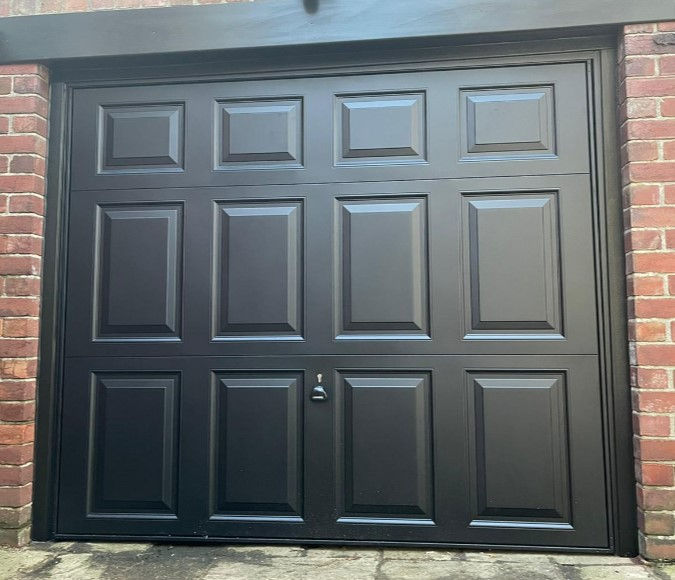How Does It Work? - Understanding Residential Canopy Garage Doors
- George Williams

- Sep 5, 2024
- 3 min read
Updated: Sep 27, 2024
Understanding the Operation of a Residential Canopy Garage Door
When considering garage door options, many homeowners lean towards designs that offer simplicity, reliability, and a space-efficient mechanism. One such popular choice is the canopy garage door. This type of door operates using a single panel that pivots upwards, forming a "canopy" over the garage entrance when open. Let’s take a closer look at how a canopy garage door operates, its key components, and why it’s an

appealing option for residential use.
The Basics: What Is a Canopy Garage Door?
A canopy garage door consists of a single solid door panel attached to vertical tracks on either side. As you lift the door, it tilts upwards, and about one-third of the door projects outside the garage, resembling a canopy. This partial extension provides the name for this door style. Unlike sectional garage doors that fold into sections, a canopy door moves in one smooth motion, which can be mechanically or manually operated.
Key Components of a Canopy Garage Door
Door Panel: The door is made of a single solid piece, commonly made of steel, wood, or composite materials. This gives the canopy door its sturdy and simple design.
Side Tracks: These are mounted vertically along the sides of the garage entrance. The tracks guide the door as it lifts or lowers, allowing it to pivot smoothly during operation.
Spring Mechanism: The spring system (often a torsion spring) provides counterbalance to the door's weight. When you open or close the door, the springs reduce the amount of force required, making it easy to operate manually.
Pivot Arms and Rollers: Pivot arms, attached to the sides of the door, enable the door to lift in a tilting motion. Rollers allow for smooth gliding along the side tracks.
Cables and Pulleys: These are essential for the balanced movement of the door. They help distribute the door’s weight evenly as it rises and lowers, preventing jerky motions or undue stress on any particular component.
How Does a Canopy Garage Door Work?
The operation of a canopy garage door is fairly straightforward, combining the coordinated action of the springs, pivot arms, and tracks. Here’s a step-by-step breakdown of the typical operation:
1. Opening the Door
When you open the garage door, the tension in the torsion springs is released gradually. This stored energy helps counteract the door’s weight, allowing it to rise with ease. The pivot arms guide the door up and forward as the rollers move along the vertical side tracks. Once fully open, about one-third of the door extends outward from the garage, forming a “canopy” over the driveway.
2. Holding Position
Once open, the door rests in this angled, extended position. The springs and tracks ensure the door remains stable and secure, preventing it from slamming shut unexpectedly. Despite the portion of the door extending out, the system is designed to be safely balanced, minimising any risk of falling.
3. Closing the Door
To close the canopy garage door, simply reverse the process. As the door lowers, the springs gradually regain tension, storing energy for the next lift. The door returns into the garage, sealing the entrance with a flush fit, and the pivot arms smoothly guide it back into place.
Advantages of a Canopy Garage Door
Simple and Low Maintenance: Fewer moving parts compared to sectional or roller doors mean less maintenance and fewer breakdowns over time.
Space-Efficient Design: Canopy doors maximise interior garage space because they do not retract entirely into the garage like other door styles. This can be especially useful for homeowners with smaller garages.
Cost-Effective: Canopy garage doors tend to be more affordable than other types of doors, making them a budget-friendly option.
Manual Ease of Use: Even without a motorised system, canopy doors are easy to operate manually due to the assistance of the spring system.
Potential Considerations
While canopy garage doors offer many benefits, there are a few aspects to consider:
Limited Automation Compatibility: Not all canopy doors can be easily automated due to the design of the pivot mechanism. If you prefer motorised operation, ensure the door is compatible with your garage opener.
Protrusion When Open: The portion of the door extending outward when opening and fully open might be a drawback if you have a short driveway or limited exterior space.
Conclusion
Canopy garage doors provide an elegant and practical solution for homeowners looking for a space-saving and easy-to-operate garage door. It’s simple yet efficient mechanism, low maintenance needs, and affordability make it a favoured choice for many residential properties. Whether you’re operating it manually or prefer the ease of automation, a canopy garage door is a reliable and convenient way to secure your garage.















Comments